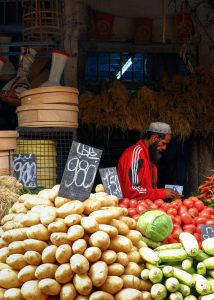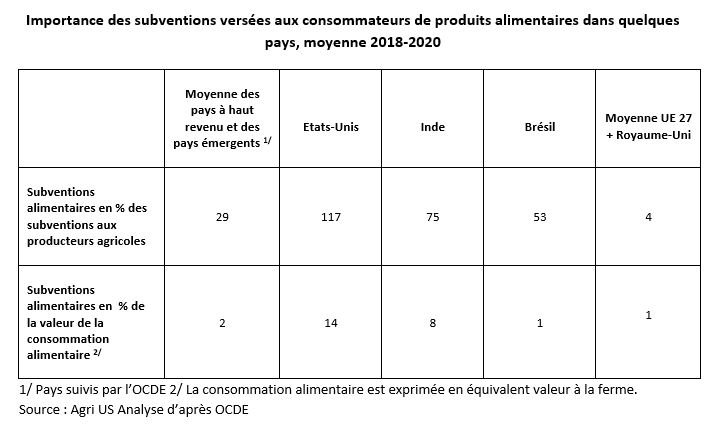Food subsidies: a promising future.
Public policies have a major role to play in achieving the Sustainable Development Goals set by the United Nations regarding food and nutrition security. But the challenge is not limited to supporting agriculture: food consumption subsidies can contribute effectively to combating hunger and malnutrition. However, there is one major obstacle: their budgetary cost.

According to the Organisation for Economic Co-operation and Development (OECD), food subsidies in major high- and middle-income countries averaged $78 billion per year over the period 2018-2020[1]. This is less than a fifth of support to agricultural producers[2], but the comparison is misleading because the data do not include large-scale food subsidies[3] provided in some countries, particularly Egypt and Iran. In the countries surveyed by the OECD, food subsidies account for 22 billion of all agricultural and food subsidies, significantly more than the 9 billion estimated on average for the predominantly low-income sub-Saharan African countries tracked by the FAO's MAFAP programme[4].
Three-quarters of the food aid recorded by the OECD is concentrated in the United States ($43.4 billion) and India ($30.4 billion), far ahead of the European Union ($3.5 billion) and Brazil ($1 billion). In the United States, the value of this aid exceeds that of agricultural subsidies. Its weight is also very significant in India and Brazil (table).

The way food aid programs operate varies from country to country. In the United States, they consist primarily of direct or indirect cash transfers to certain social groups (low-income people, pregnant women, schoolchildren, etc.). In India, the Public Distribution System (PDS) takes the form of in-kind donations, taken from grain stocks purchased from farmers by the central government. In both cases, the programs reach a very large number of people, both adults and children.
A context conducive to an increase in aids
The second Sustainable Development Goal (SDG), of the 17 set by the UN for 2030, primarily aims to eliminate hunger and end all forms of malnutrition[5]. It is clear that it will not be achieved. Under the impact of extreme weather events, armed conflicts and, more recently, the Covid-19 pandemic, the proportion of undernourished people has increased from around 8% in 2014 to almost 10% in 2020; almost a third of the world's population does not have access to adequate food. Yet these figures mask enormous regional disparities[6]. At the same time, on all continents, obesity is on the rise.
The scientific syntheses prepared for the recent United Nations Food Systems Summit are edifying[7]. More than 1.5 billion people (57 billion of the population in sub-Saharan Africa, 38 billion in South Asia) cannot afford a “healthy and nutritious” meal, as defined in a reference study[8]. The price of the latter is generally higher than that of a conventional meal, because it includes more expensive ingredients, such as fruits and vegetables or fish[9]. However, this price is expected to increase further in the medium term, due to several factors:
- declining crop yields due to climate change;
- the increase in production costs experienced by farmers and processors of agricultural products, in particular due to the adoption of more sustainable practices which are likely to reduce productivity;
- the emerging consensus among experts in favor of internalizing the "hidden" health and environmental costs of food, which should logically result in a higher price for food.
All this in a global context marked by the depressive effect that the transition to a greener economy will have on household consumption, at least in the short term, requiring a sharp increase in investment in new technologies[10].
All countries are affected, and within each of them, the poorest people are clearly the most vulnerable. The payment of food aid, targeted at the most deprived, therefore appears to be a potential instrument for improving public health, with a view to social justice. Thus, the French government is considering the launch of a "food voucher," proposed by the Citizens' Climate Convention, which would both enable the acquisition of basic foodstuffs and boost the income of farmers offering products considered healthier and/or more environmentally sustainable.
A potentially high cost
While almost everyone agrees on the diagnosis, opinions differ as to the role that food subsidies could play in the array of measures envisaged to encourage the adoption of healthier diets. To achieve this objective, it is necessary to both reduce the cost of nutritious foods and facilitate household access to these products. This involves action throughout the food supply chain to encourage companies to be more efficient, at all levels (production, storage, processing, packaging, distribution, and marketing of foodstuffs), but also implementing policies aimed at reducing income inequality, linking social protection and nutrition, and promoting new consumption habits. The cost of all these measures could prove exorbitant for public finances, particularly in countries with limited budgetary resources.
The two countries studied by the OECD that have the most extensive food aid programs clearly demonstrate the scale of the problem. In India, the government is seeking to reduce the heavy bill for the PDS, despite protests from beneficiaries. In the United States, spending on nutrition programs has exploded with Covid-19 (+32 billion in 2020). In fact, because of their targeting of populations most exposed to hunger and malnutrition, food subsidies tend to increase in the event of economic, climatic, or health hazards affecting the people concerned.
The impact on agricultural policies
A coherent public policy dedicated to achieving the SDGs must influence both the supply and demand for food products. It is therefore difficult to imagine that food aid could be substantially increased without a concomitant reorientation of agricultural support aimed at increasing the production of certain foods: vitamin-rich fruits and vegetables, plant-based and animal-based foods with a high protein content (legumes, poultry, fish, dairy products, etc.). The definition of a "healthy and nutritious" diet, and the list of products whose production and consumption should be promoted, naturally vary according to the local nutritional profile and eating habits.
Another consequence for agricultural policies is the positive image of farmers that food aid can create in the public eye, particularly when it allows beneficiaries to source their food from short supply chains. This is the case, for example, in the United States, where a significant portion of purchases by the poorest, under the SNAP (Supplemental Nutrition Assistance Program, formerly known as the Food Stamp Program), take place at farmers' markets.
Finally, agricultural support is accused of so many ills – often in a dogmatic and implausible manner[11] – that it would be interesting to explore the extent to which an increase in food subsidies could replace the reduction or reorientation of subsidies to producers. Food aid does indeed fall, under certain conditions, into the "green box" of the Agreement on Agriculture at the World Trade Organization and is therefore exempt from reduction commitments. But such an option, focused exclusively on supporting the consumption of food products, can only play a marginal role. It does not constitute a serious alternative for the many low- and middle-income countries that do not have the political will or the financial means to invest in the agricultural sector to the extent that it faces the challenges it poses. In terms of both production and sustainable consumption, in the disarray surrounding the chaotic march towards the SDGs, these challenges are now becoming apparent in all their magnitude.
[1] OECD (2021), Agricultural Policy Monitoring and Evaluation 2021: Addressing the Challenges Facing Food Systems, OECD Publishing, Paris.
[2] The OECD Producer Support Estimate (PSE) includes: (i) subsidies paid to farmers through budgetary transfers, excluding export subsidies; (ii) transfers to farmers resulting from agricultural price support, financed mainly by consumers (and by taxpayers, in the case of export subsidies). The PSE does not include food subsidies.
[3] In this article, the terms "food subsidies", "food subsidies", "food aid", "food aid" and "food consumption aid" are used interchangeably.
[4] Pernechele, V., Fontes, F., Baborska, R., Nkuingoua, J., Pan, X. & Tuyishime, C. (2021), Public expenditure on food and agriculture in sub-Saharan Africa: trends, challenges and priorities, Rome, FAO.
[5] “By 2030, end hunger and ensure access by all people, in particular the poor and those in vulnerable situations, including infants, to safe, nutritious and sufficient food all year round” (target 2.1); “By 2030, end all forms of malnutrition, including achieving by 2025 the internationally agreed targets on stunting and wasting among children under 5 years of age, and address the nutritional needs of adolescent girls, pregnant and lactating women and older persons” (target 2.2).
[6] According to FAO, the prevalence of undernourishment in 2020 was around 24% in sub-Saharan Africa and 16% in South Asia. Source: FAO, IFAD, WHO, WFP and UNICEF (2021), Summary of The State of Food Security and Nutrition in the World 2021. Transforming food systems for food security, improved nutrition and affordable, healthy diets for all, Rome, FAO.
[7] United Nations Food Systems Summit 2021, Scientific Group Reports, www.sc-fss2021.org
[8] Hirvonen, K. et al. (2020), Affordability of the EAT–Lancet reference diet: a global analysis, The Lancet Global Health, 8(1), pp. e59–e66.
[9] Does more sustainable food increase consumers’ budgets? Climate Point No. 67, I4CE, October 2021.
[10] Jean Pisani-Ferry, Ecology needs a macroeconomic policy, Le Grand Continent, September 1, 2021.
[11] Jean-Christophe Debar, Reorienting support for agriculture: a report that leaves you wanting more, FARM Blog, October 6, 2021, http://www.fondation-farm.org/zoe.php?s=blogfarm
